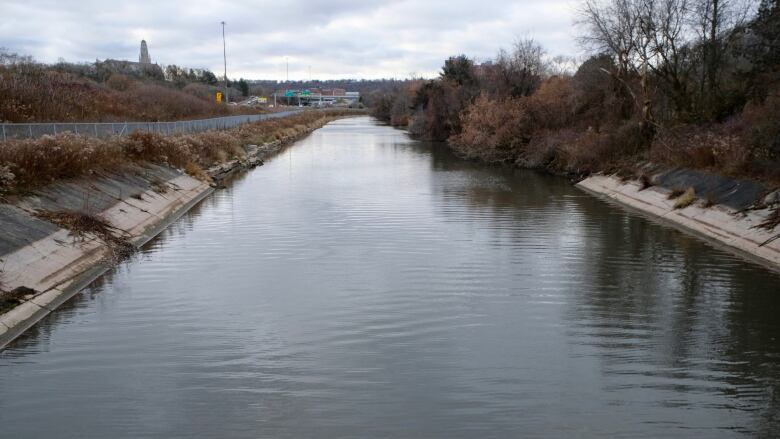7 takeaways from the formerly confidential reports into the Chedoke Creek leak
Dredging is suggested as the most effective cleanup approach

Formerly confidential reports reveal newdetails about the massive sewage and runoff spill in Chedoke Creek.
The 10 reports were made public by council following a marathon meeting Wednesday, where members also voted to formally apologize to the community for not notifying residents about the volumeand length of the leak that allowed an estimated 24 billion litres of runoff and sewage to leech into the water way over more than four years.
Here's a look at seventakeaways from the expert reports.
A trail of organic material leading toCootes Paradise
There's a mat of "organic material" about 16 metres wide with an average thickness of about 27 cm (almost a foot) along the section of the creek bed between the Main King CSO, where the leak happened, and Cootes Paradise.
Chemical analysis indicates that material might be a "potentially significant source" of faecal coliform bacteria.

"Based on elevated concentrations of faecal coliformand nutrients, the soft sediments within Chedoke Creek may have been deposited over the duration of the discharge event," it reads, before noting the presence of that material could also be from other discharges from before the leak.
Thereport saysthe conditions in the creek were "likely degraded long before the leak."
That said, larger, heavier bits of the2,375 tonnes of solids estimated of have entered the creek during the leak would have settled along the creek bed during low flow conditions, according to the report.
City had an idea of leak's scale in September
The city had a rough confirmation of the scale of the leakas far back as September and probably earlier.
A Quantification of Volume and Contaminant Loadings report dated Sept. 28, 2018 gives an estimation of 24 gigalitres (24 billion litres).
It states the amount "is greater" than what the city reported to the Ministry of Environment, Conservation and Parks back on July 27, 2018, about the time the leak was first discovered and stopped.
How many tonnes of contaminants?
The spill was 24 billion litres of combined stormwater run off and sewage. But how much of that total flow was contaminants? More than 4,000 tonnes, according to a September 2018 report. That report quantifies what pollutants and how much of each flowed into the creek. But it does so by weight not volume.
The contaminant report shows the gate was left0.148m open (about six inches) allowing material to leak out during wet weather. But when a second gate failed sometime inn January 2018 records from the city's monitoring system show sewage and runoff began leaking into the creek even when the weather was dry.
Over the four years the report estimated 4,266tonnes of contaminantswere allowed into the waterway:
- 2,375 tonnes of solids.
- 47 tonnes of phosphorus.
- 159 tonnes of ammonia.
- 312 tonnes of nitrogen.
- 1.373 tonnes of carbonaceous biochemical oxygen demand.
Cleanup options
When it comes to remediation,the report suggests the issues introduced by that organic material could be addressed by covering it in clean sediment, chemical inactivation to reduce the release of phosphorus and direct removal through dredging which is considered the most effective approach.
Did closing the gate make a difference?
An assessment found the water quality where the creek meets Cootes Paradise declined "significantly" after 2014 when the leak began and that both phosphorous and E. coliwere "substantially higher" at that location than what was found in samples taken upstream.
But after the open gate was discovered and shut phosphorousconcentrations were reduced by 90 pre cent and E. coli concentrations about 99.9 per cent during the dry days after the leak was stopped.
Planning to dredge the creek, but not consulting
In January, consultants reminded the city many other agencies have a stake in the health of the creek and it would need to start talking to them. The city's failure to keep those agencies, such as the Royal BotancialGardens and local conservation authorities, informed has been a significant criticism of its handling of the affair.
The province's first order against thecity required it to come up with a plan to remediate the creek. It hired consultants to do so and in January it got a report outlining an ambitiousplan to dredgethe sediments from the creek. That plan included a very general $2 million cost estimate.
That report also said "it is recognized that the City of Hamilton, in addressing this Provincial Officer's Order, has been conducting the assessment in the absence of broad consultation with agencies, stakeholders and the public and it is fully expected that there will be requirements for broader engagement of stakeholders to this undertaking."
It notes that an environmental assessment will likely be required and that a key requirement to that EA process is broad consultation. "Given this approach, the primary action which will be required to ... will involve more comprehensive stakeholder consultation."
Why council hired new inspectors for the sewage system
As the outcry over the scandal grew Councillor Tom Jackson moved a motion that the city hire new staff to physically inspect the city's nine giant CSO tanks, as a further protection against future incidents. That action was a key recommendation from a report received by the city more than a year ago.
In October 2018 Hatch was hired to inspect the tanks and recommend any steps to make them safer. For each tank it recommended the city develop a planto physically inspect them and test the machinery in each tank. It recommended physical inspections even though it also recommended adding extra remote sensors andmeters to monitor the system.













_(720p).jpg)


 OFFICIAL HD MUSIC VIDEO.jpg)
.jpg)



























































































